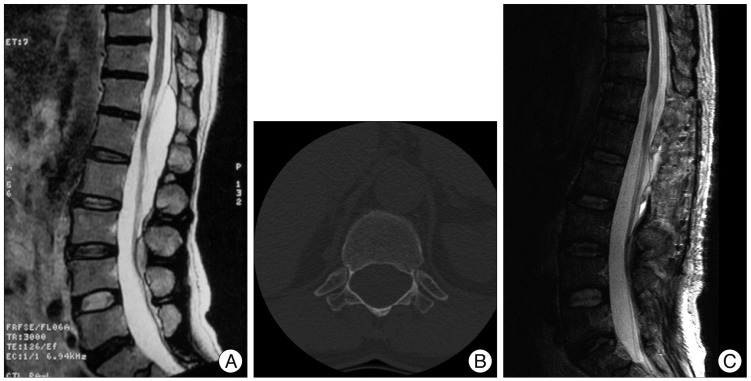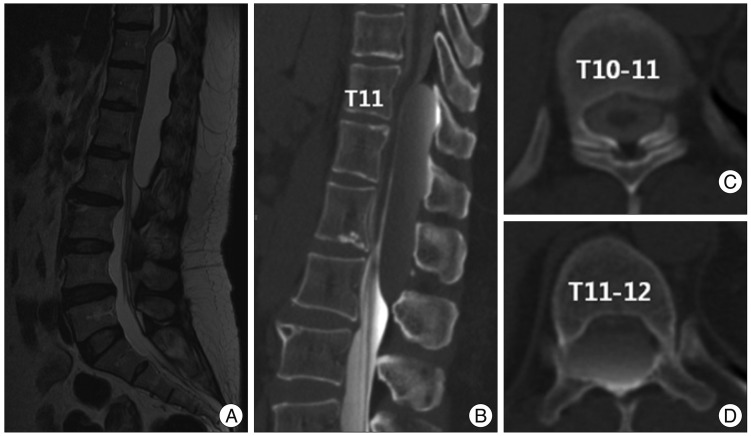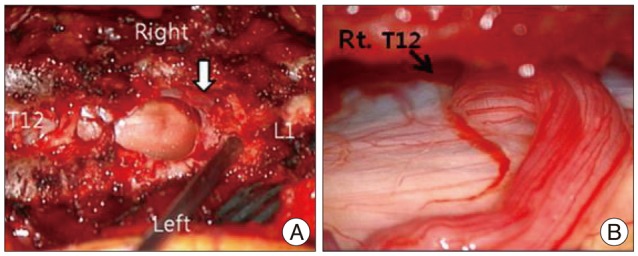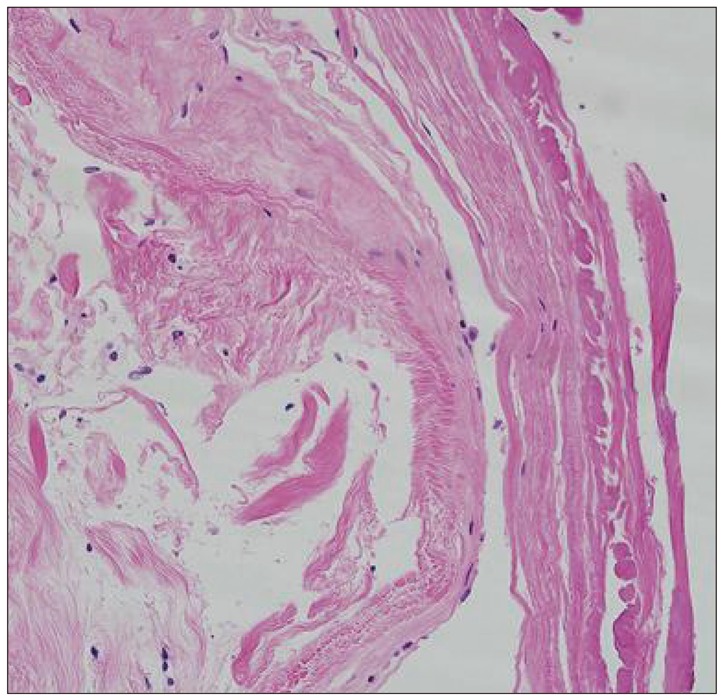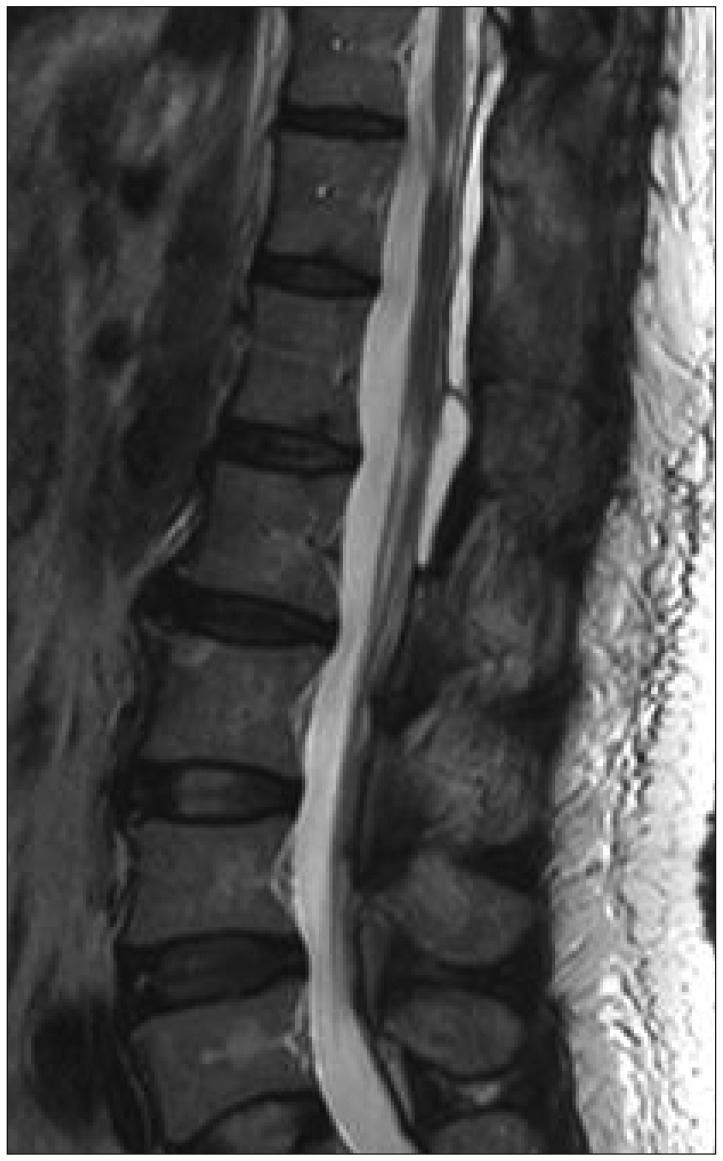J Korean Neurosurg Soc.
2013 Oct;54(4):355-358. 10.3340/jkns.2013.54.4.355.
Spinal Extradural Arachnoid Cyst
- Affiliations
-
- 1Department of Neurosurgery, Asan Medical Center, University of Ulsan College of Medicine, Seoul, Korea. swroh@amc.seoul.kr
- KMID: 1499345
- DOI: http://doi.org/10.3340/jkns.2013.54.4.355
Abstract
- Spinal extradural arachnoid cyst (SEAC) is a rare disease and uncommon cause of compressive myelopathy. The etiology remains still unclear. We experienced 2 cases of SEACs and reviewed the cases and previous literatures. A 59-year-old man complained of both leg radiating pain and paresthesia for 4 years. His MRI showed an extradural cyst from T12 to L3 and we performed cyst fenestration and repaired the dural defect with tailored laminectomy. Another 51-year-old female patient visited our clinical with left buttock pain and paresthesia for 3 years. A large extradural cyst was found at T1-L2 level on MRI and a communication between the cyst and subarachnoid space was illustrated by CT-myelography. We performed cyst fenestration with primary repair of dural defect. Both patients' symptoms gradually subsided and follow up images taken 1-2 months postoperatively showed nearly disappeared cysts. There has been no documented recurrence in these two cases so far. Tailored laminotomy with cyst fenestration can be a safe and effective alternative choice in treating SEACs compared to traditional complete resection of cyst wall with multi-level laminectomy.
MeSH Terms
Figure
Cited by 1 articles
-
Spinal Extradural Arachnoid Cyst
Joon Bum Woo, Dong Wuk Son, Kyung Taek Kang, Jun Seok Lee, Geun Seong Song, Soon Ki Sung, Sang Weon Lee
Korean J Neurotrauma. 2016;12(2):185-190. doi: 10.13004/kjnt.2016.12.2.185.
Reference
-
1. Choi JY, Kim SH, Lee WS, Sung KH. Spinal extradural arachnoid cyst. Acta Neurochir (Wien). 2006; 148:579–585. discussion 585. PMID: 16505968.
Article2. Doita M, Nishida K, Miura J, Takada T, Kurosaka M, Fujii M. Kinematic magnetic resonance imaging of a thoracic spinal extradural arachnoid cyst : an alternative suggestion for exacerbation of symptoms during straining. Spine (Phila Pa 1976). 2003; 28:E229–E233. PMID: 12811286.3. Hatashita S, Kondo A, Shimizu T, Kurosu A, Ueno H. Spinal extradural arachnoid cyst--case report. Neurol Med Chir (Tokyo). 2001; 41:318–321. PMID: 11458745.4. Kim IS, Hong JT, Son BC, Lee SW. Noncommunicating spinal extradural meningeal cyst in thoracolumbar spine. J Korean Neurosurg Soc. 2010; 48:534–537. PMID: 21430982.
Article5. Kim K, Chun SW, Chung SG. A case of symptomatic cervical perineural (Tarlov) cyst : clinical manifestation and management. Skeletal Radiol. 2012; 41:97–101. PMID: 21830055.
Article6. Lee CH, Hyun SJ, Kim KJ, Jahng TA, Kim HJ. What is a reasonable surgical procedure for spinal extradural arachnoid cysts : is cyst removal mandatory? Eight consecutive cases and a review of the literature. Acta Neurochir (Wien). 2012; 154:1219–1227. PMID: 22573100.
Article7. Lee MC, Lee JK, Wee SC, Kim TS, Kim JH, Kim SH, et al. Spinal extradural meningeal cyst : case report. J Korean Neurosurg Soc. 1998; 27:407–411.8. Miyamoto M, Kim K, Matsumoto R, Isobe M, Isu T. Utility of preoperative magnetic resonance imaging myelography for identifying dural defects in patients with spinal extradural arachnoid cysts : case report. Neurosurgery. 2006; 59:E941. discussion E941. PMID: 17038930.9. Nabors MW, Pait TG, Byrd EB, Karim NO, Davis DO, Kobrine AI, et al. Updated assessment and current classification of spinal meningeal cysts. J Neurosurg. 1988; 68:366–377. PMID: 3343608.
Article10. Netra R, Min L, Shao Hui M, Wang JC, Bin Y, Ming Z. Spinal extradural meningeal cysts : an MRI evaluation of a case series and literature review. J Spinal Disord Tech. 2011; 24:132–136. PMID: 21430498.11. Neulen A, Kantelhardt SR, Pilgram-Pastor SM, Metz I, Rohde V, Giese A. Microsurgical fenestration of perineural cysts to the thecal sac at the level of the distal dural sleeve. Acta Neurochir (Wien). 2011; 153:1427–1434. discussion 1434. PMID: 21562735.
Article12. Oh JK, Lee DY, Kim TY, Yi S, Ha Y, Kim KN, et al. Thoracolumbar extradural arachnoid cysts : a study of 14 consecutive cases. Acta Neurochir (Wien). 2012; 154:341–348. discussion 348. PMID: 21842210.
Article13. Payer M, Brühlhart K. Spinal extradural arachnoid cyst : review of surgical techniques. J Clin Neurosci. 2011; 18:559–560. PMID: 21256754.
- Full Text Links
- Actions
-
Cited
- CITED
-
- Close
- Share
- Similar articles
-
- Septated Extradural Arachnoid Cyst in Thoracolumbar Spine Causing Myelopathy
- Extradural Spinal Arachnoid Cyst as a Cause of Cauda Equina Syndrome in a Child
- Multiple Extradural Arachnoid Cyst : A Case Report
- Retroperitoneal Spinal Extradural Arachnoid Cyst Combined with Congenital Hemivertebrae
- Huge Thoracolumbar Extradural Arachnoid Cyst

